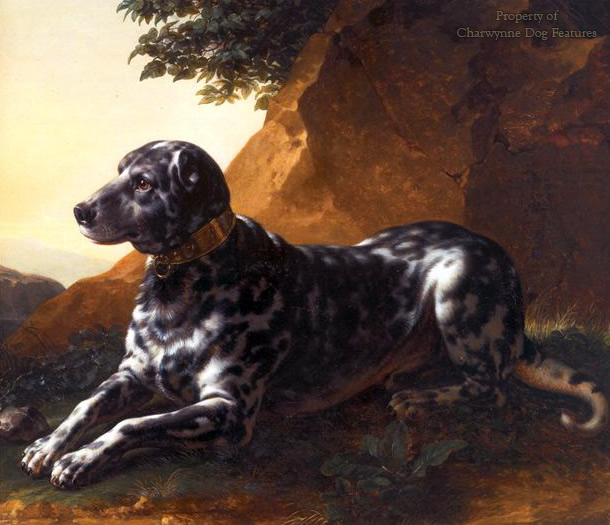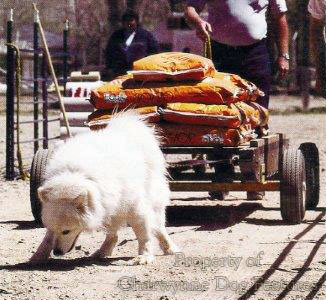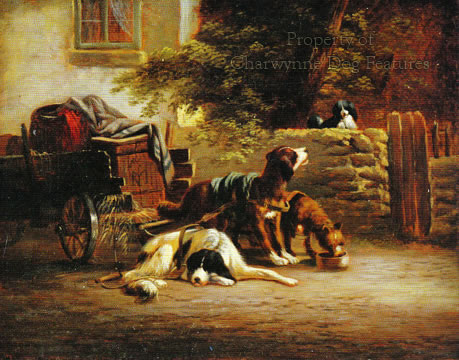338 Coach Dogs
PULLING POWER-THE CARRIAGE DOGS
by David Hancock
 "Spotted like a leopard, I
"Spotted like a leopard, I
Live my days at Dobbin's heels,
Let the hastening pack go by,
With tootling horn and bellowing cry;
I am content between the wheels."
Those words from 'The Spotted Dog' neatly sum up the inbred instinct of the breed of Dalmatian, once dubbed the Coach Dog, for running with horse-drawn vehicles. The coach dogs added style and protection to the carriages and their contents, but it was not always horses that did the pulling. To this day on the continent of Europe, dogs are still used to pull carts, as the Bernese Mountain Dog fanciers sometimes demonstrate at their shows in Britain. A century ago, Professor Reul, one of the founders of the Belgian Club for Draught Dogs, wrote: "The dog in harness renders such precious services to the people, to small traders and to the small industrials (agriculturists included) in Belgium that never will any public authority dare to suppress its current use."
Taplin, writing in The Sportsman's Cabinet of 1804 on Dutch dogs, stated that: "...there is not an idle dog of any size to be seen in the whole of the seven provinces. You see them in harness at all parts of The Hague, as well as in other towns, tugging at barrows and little carts, with their tongues nearly sweeping the ground, and their poor palpitating hearts almost beating through their sides; frequently three, four five, and sometimes six abreast, drawing men and merchandize with the speed of little horses." In Britain too, draught dogs were widely used, until, because of the huge increase of traffic in London, compounded by the widespread ill-treatment of the dogs, led to this practice being forbidden by law.
Dogs were used instead of ponies to pull the carriages of some eccentric sportsmen in the 19th century. In Lawrence's The Sporting Repository of 1820 there is reference to a man who "exhibited a carriage drawn by six dogs. These were the largest and most powerful which we have ever witnessed." Another man boasted of the pulling feats of his 'Siberian Wolf-dog', which pulled a dog-cart unaided. In Shropshire, Squire Danville Poole used a pack of black and tan terriers to keep the local curs away from his horse-drawn carriage. I could imagine many of the working terriers I see at country shows relishing such a task.
Many of the large powerful draught-dogs in the Low Countries descended from "matins", once used as boar-lurchers in the hunt. These determined coarsely-bred dogs were used at the kill, so as not to risk the more valuable boarhounds on the boar's tusks. The wild boar is a formidable quarry, with many dogs being killed in their hunting. As boar-hunting lapsed, largely because of the scale of slaughter by reckless hunters, a new employment was found for such strong willing dogs, in the commercial dog-cart market. The Belgian matin, a distinct type, is being restored by a devoted group of fanciers, led by Johan Gallant, at the present time.
The Dalmatian preferred to run with other bigger carriages rather than pull carts. In 1940, Keeler and Trumble published a study on inherited tendencies in Dalmatians when used as coach dogs. They concluded that some dogs prefer to run close to the horses, under the coach, while others preferred to adopt a running position further back by the rear wheels. They considered that such preferences were inherited to some degree. I understand that when harlequin Great Danes were used as coach dogs their preference was to follow the coach or flank it, not run beneath, although size may have come into this decision. It is of interest too that Dalmatians retain their love of horses even when never employed as coach dogs.
In his 'The Dogs of the British Islands' of 1878, 'Stonehenge' wrote: "Our English pointers will follow a dogcart quite as closely (i.e. as a Dalmatian) and I have had more than one which would occupy the place generally selected by the Dalmatian, close behind the horse's heels"; he added however that the Pointers followed the cart because they associated it with a trip to the shooting field. His Greyhounds would also follow the cart but only from a distance of 100 yards or more. The coach dogs running with the big 'inter-city' coaches covered remarkable distances and faced every kind of trial, from assaults by village curs to deep fords which they had to swim.
In his book on the Dalmatian, published in 1932, James Saunders records how one dog, in 1851, made the London to Brighton trip, 74 miles each way along the route taken by coaches, on eight successive days. This same dog once ran with a coach proceeding to Tunbridge Wells not Brighton as usual, and, when the coach remained overnight in Tunbridge Wells, made its own way to Brighton, returning to London with another coach. In his 'Dogs of Britain' of 1948, the late Clifford Hubbard wrote on the breed: "Not until about 1665 does any evidence appear of it being used in its now traditional role of coach-dog. By 1670 it was certainly used in France as an accessory to travel by coach, and was invaluable as a guard against highwaymen."
This guarding role was covered in an article by a Major TJ Woodcock in 1891: "A good Coach Dog has often saved his owner much valuable property by watching the carriage. It is a trick of thieves who work in pairs for one to engage the coachman in conversation while the other sneaks around in the rear and steals whatever robes and other valuables he can lay his hands on. I never lost an article while the dogs were in charge, but was continually losing them when the coachman was in charge." The role of the coach-dog was therefore much more than decorative, although the sight of distinctive-looking dogs running with the carriage undoubtedly added style and a touch of elegance to the whole scene.
The 'pulling power' of the Dalmatian lies more in the modern idiomatic sense of physical appeal than in the sheer strength of the draught dogs, but it did lead to their association with fire brigades in America. This was in the days of horse-drawn fire tenders; the Dalmatian moved in to live with the horses. In New York City, Captain Donovan was both a fire chief and a Dalmatian breeder. He provided a pup as a mascot for many fire-stations in the city. One of these was shown at Madison Square Garden in 1910, where there was a special class for the Dalmatians of the fire service. Interestingly, when the department became mechanized, the dogs showed little interest in following the motorized vehicles; it was the horses they instinctively followed. 
Less glamorous but even more useful were the draught dogs, using their more direct pulling power. The 'Trekhond' in Holland, the 'Ziehhund' in Germany and the 'Chien de Trait' in France became the small work-horses of Western Europe. Bylandt in his 'Dogs of all Nations' of 1904 described such dogs as being: from 26 to 31½ inches in height at the shoulder, weighing a minimum of 112lbs for the dogs and 100lbs for the bitches, rather short-muzzled, with docked tails and usually fawn or brindle with a black mask. These are the colour combinations of the mastiff breeds, which manifested themselves in the matins, a type of dog rather than a breed.
In the countries where draught-dogs were once utilised, the local authorities regulated their use. In Belgium it was not permitted to: harness dogs smaller than 24" at the shoulder, use old or sick dogs, bitches in whelp or still suckling, harness a dog with another animal, allow the dog to be controlled by someone under 14 years old, convey passengers or leave harnessed dogs in the sun in hot weather. The traces had to be at least a yard long and the collar and any harness in contact with the dog had to be padded. Any vehicle towed by dogs had to have springs and be fitted with brakes. A single dog could only pull 300lbs and two or more dogs 400lbs, including the vehicle's weight.
The Swiss made most use of the Great Swiss Mountain Dog, not yet seen in Britain, and the Bernese Mountain Dog, now rightly a firm favourite here. In Brussels and Antwerp a century ago, a good draught-dog could be bought for the equivalent of £4. The dogs were fed on a mixture of stale bread and horsemeat. Some enthusiasts would course their dogs over two or three miles, with the public able to place wagers on each contestant. In Portugal and Spain dog-carts were utilised to deliver the casks of grapes from the vineyards and the cork from the forests. The dogs used resembled today's Estrela Mountain Dog in Portugal and the Spanish Mastiff in Spain.
Draught dogs were not only cheaper to employ than horses but were much more manoeuverable. Importantly too, their drivers were not required to pay tolls. Despite this, the use of dog-carts was never widespread in Scotland, perhaps because of the long distances between towns. When the railways came, dog-drawn carts were used in the south of England to carry fish from the ports to the railheads. Some made the journey from Brighton to Portsmouth in one day, returning the following day. Humanitarians argued that dogs' paws were never designed to cope with hard sharp-stoned roads, whatever their widespread and indispensable use over snow in Arctic countries.
Some critics suggested that dog-carts frightened horses and vets even cited such use as a means of spreading rabies! The use of dog-carts in England was ended by piecemeal legislation. In 1839 a clause in the Metropolitan Police Act denied the use of dogs as beasts of burden within 15 miles of Charing Cross. This alone resulted in the destruction of more than 3,000 dogs. When an anti-dogcart bill was being introduced in 1854, the Earl of Malmesbury stated that in Hampshire and Sussex alone there were 1,500 people earning a living from dog-carts.
In the debate, Lord Brougham spoke of a dog-cart driver who had ripped up an exhausted dog and given its entrails to two other dogs for food. The Earl of Eglington, opposing the bill, forecast the destruction of between 20,000 and 30,000 dogs. The Bishop of Oxford stated that ill-used dogs had been traced for distances of up to 20 miles by following blood trails on the highway. He claimed that it was not unusual for a dog to be driven 40 or 50 miles on a hard road until it could just not continue, when it would be destroyed and replaced by a fresh dog. The bill went through. 
Some of the breeds used abroad as draught dogs became recognised and are still with us. The Swiss breeds are probably the best known, with even the St Bernard finding employment in this way. The Newfoundland was utilised in its home country to pull fish-carts, while Dogue de Bordeaux crosses were employed as cart-dogs in the south of France. The Leonberger, the Rottweiler and even the German Shepherd Dog, have all been used too in this way. In Britain today the pulling power of Bull Terrier crosses is often tested by their owners, using rubber-wheeled trailers. Some of the so-called Irish Staffies putting in quite remarkable feats of pulling for their body weight.
Sadly in these days when brave determined dogs are singled out by ignorant authorities for suspicion under the discredited Dangerous Dogs Act, weight-pulling contests are regarded by some not very bright policemen as a way of improving the fitness of dogs being trained to fight. I have attended two or three events where weight-pulling was conducted and was impressed first of all by the dogs' enthusiasm and secondly by the affection of their owners. The misplaced suspicion of the police towards such activities is regrettable. In these days when so many dogs are under-exercised and under-employed any encouragement of dogs at work is surely wholly admirable. I would be the first to inform the police if I ever suspected that dogs were being misused.
Perhaps the greatest pleasure enjoyed by dogs is that of being employed, being useful to their owners, being exercised with a mission. I am not advocating a return to dog-carts, there would be a risk of cruelty from some owners. But despite the brutality of the motorcar age, it would be a source of delight to see Dalmatians running with coaches once more, even on private roads or in parks. It would be satisfying too to see working tests for big dogs, designed to test their strength and application, but also to employ them, help them to feel useful, develop their spirit and counter the sheer boredom of most of the daily lives. Dogs desperately want to serve us!
